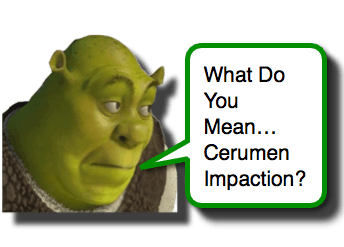Cerumen Impaction
Certainly, knowing critical care topics (ex, ECMO in ED, Submersion Injuries, Optimize Chest Compressions, and Non-Invasive Ventilation) is vital to being effective in the ED, but mastery of less critical topics (ex, Rash Evaluation, Recurrent Abdominal Pain, Growth, Development, and Fish Hook Injuries) helps optimize efficiency in the ED. One issue that can derail a “simple” evaluation is Cerumen Impaction.
Cerumen: It’s Natural!
- Cerumen might repulse parents and hinder your ability to see the Tympanic Membrane (TM), but it serves a purpose.
- Emollient of the ear canal
- Bactericidal material
- Cerumen is a mixture of:
- Epithelial cells from the TM and canal,
- Sebum,
- Secretions from apocrine sweat glands,
- Dirt and small particles.
- The Cerumen naturally migrates from the middle aspect of the canal outward.
- Like a good stove, the ear is “self-cleaning.”
- Movement of the jaw assists with the nature migration outward.
- So, anything that interferes with this process can lead to impaction.
- Anatomic anomalies (ex, stenotic ear canals seen with Down’s Syndrome)
- Excess cerumen production
- Ear Plugs
- Cotton-Tip Applicators
- Commonly associated with cerumen impaction [Macknin, 1994]
- Do more harm by pushing cerumen deeper and leaving cotton fibers behind.
- Good to reinforce avoiding the use of these, or any objects, to insert into the ear canal.
- Foreign Bodies
- Hearing Aids
Cerumen: Impaction
- Cerumen impaction is present in ~10 % of children.
- Impaction does not require complete obstruction of the canal.
- Impaction implies symptomatic state or obscuring the view of the TM.
- Cerumen impaction symptoms:
- Pain
- Cough
- Tinnitus
- Fullness
- Itching
- Hearing loss
- Odor
Removal Methods
- No single way is perfect, so knowing several is useful. [Roland, 2008]
- Manual Removal
- Curettage with direct visualization using cerumen “spoons”
- Risk of trauma to ear canal and/or TM
- Benefit is that it does not introduce moisture into the canal.
- Cerumenolytic agents
- Chemicals that soften / emulsify cerumen
- Several options, but none have been proven to be superior to any other, and saline is just as effective. [Burton, 2009]
- Seem to work best when applied 15-30 min before irrigation.
- Some common options:
- Liquid Docusate Sodium – 150mg/15mL, 1 mL in ear canal.
- Triethanolamine polypeptide oleate-condensate (AKA, Cerumenex) – fill canal with liquid and irrigate in 15-30 min.
- Multiple over the counter products available.
- Risk of skin irritation, pain, and vertigo (if TM is not intact).
- Irrigation
- Effective, but most efficient (using less fluid) if preceded by cerumenolytic.
- Risk of trauma and pain.
- Systems or techniques that direct fluid toward wall of ear canal, rather than directly toward the TM are preferred. [Roland, 2008]
Moral of the Morsel
- Ok, so having a Morsel about cerumen impaction seems less than exotic and cutting edge, but sometimes we can get carried away with digging in kids’ ears.
- Before you go wrestling the kid to the ground with a hard, icepick-like device poised precariously above the TM or before you order that docusate and add 30 min to the ED stay, ask yourself, is this a Cerumen Impaction?
- Is this cerumen potentially causing the child’s symptoms (ex, pain, dizziness, cough)?
- Is this cerumen obscuring my view of the TM and is visualizing the TM important to me today?
- This is where the idea of watchful waiting for Acute Otitis Media comes into play.
- If the child presents with a fever and is over 2 years of age, even if there is a definitive AOM, watchful waiting would be appropriate.
- Digging in, or irrigating, the child’s ear canal will likely cause redness of the TM and canal, potentially complicating the diagnosis even after cerumen removal.
- If watchful waiting is appropriate, perhaps it is just as good to discuss with the family that the presentation is consistent with a febrile illness, which may also include an AOM, but rather than wrestle the child today, we could apply cerumenolytic at home over the next 1-2 days, and then have the child and ear re-examined if ear symptoms persist.
- Share Decision Making may take you a little bit of time to explain and discuss, but may save you time and sweat in the end.
References
Propst EJ1, George T, Janjua A, James A, Campisi P, Forte V. Removal of impacted cerumen in children using an aural irrigation system. Int J Pediatr Otorhinolaryngol. 2012 Dec;76(12):1840-3. PMID: 23040963. [PubMed] [Read by QxMD]
Burton MJ1, Doree C. Ear drops for the removal of ear wax. Cochrane Database Syst Rev. 2009 Jan 21;(1):CD004326. PMID: 19160236. [PubMed] [Read by QxMD]
Roland PS1, Smith TL, Schwartz SR, Rosenfeld RM, Ballachanda B, Earll JM, Fayad J, Harlor AD Jr, Hirsch BE, Jones SS, Krouse HJ, Magit A, Nelson C, Stutz DR, Wetmore S. Clinical practice guideline: cerumen impaction. Otolaryngol Head Neck Surg. 2008 Sep;139(3 Suppl 2):S1-S21. PMID: 18707628. [PubMed] [Read by QxMD]
Dimmitt P1. Cerumen removal products. J Pediatr Health Care. 2005 Sep-Oct;19(5):332-6. PMID: 16202844. [PubMed] [Read by QxMD]
Whatley VN1, Dodds CL, Paul RI. Randomized clinical trial of docusate, triethanolamine polypeptide, and irrigation in cerumen removal in children. Arch Pediatr Adolesc Med. 2003 Dec;157(12):1177-80. PMID: 14662569. [PubMed] [Read by QxMD]
Singer AJ1, Sauris E, Viccellio AW. Ceruminolytic effects of docusate sodium: a randomized, controlled trial. Ann Emerg Med. 2000 Sep;36(3):228-32. PMID: 10969225. [PubMed] [Read by QxMD]
Macknin ML1, Talo H, Medendrop SV. Effect of cotton-tipped swab use on ear-wax occlusion. Clin Pediatr (Phila). 1994 Jan;33(1):14-8. PMID: 8156721. [PubMed] [Read by QxMD]



[…] Cerumen Impaction — Pediatric EM Morsels […]